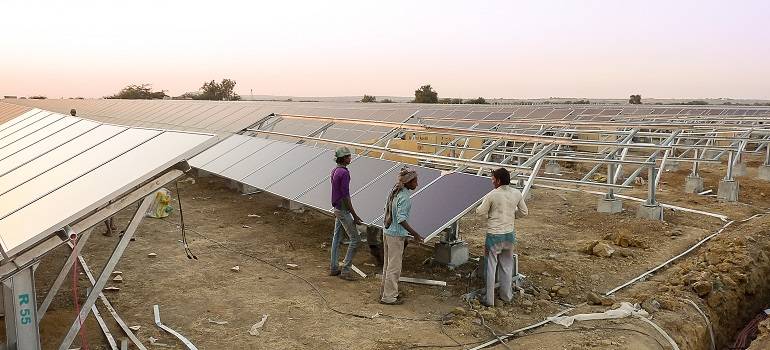
The Rs 48,000-crore KUSUM scheme to promote the use of solar power among farmers would be placed before the Cabinet by next month, New and Renewable Energy Minister R K Singh said today.
KUSUM (Kisan Urja Suraksha Evam Utthaan Mahaabhiyan) aims to incentivise farmers to run solar farm water pumps and use barren land for generating solar power to have extra income. The total cost of the capacities under this scheme would be Rs 1.4 lakh crore. The Centre will provide Rs 48,000 crore financial assistance under the scheme.
“The scheme is ready…It should go to the Cabinet in the next 20 days,” Singh told reporters on the sidelines of International R&D Conclave here.
KUSUM will also improve the present scheme for rooftop solar systems. The government is enlarging the scope of the existing scheme and its mechanism, he said adding that the government is thinking of beginning KUSUM with 7.5 lakh solar pumps.
“We are packaging the scheme in such a way that farmers also get extra income by having extra solar capacity which can be fed into the grid. We are executing it through discoms so that the reach is better,” the minister said.
As much as 30 per cent of the cost of solar pumps was provided by the government in the earlier scheme. The new scheme would be more broad-based like incentives for discoms to buy power from farmers and financial assistance of 60 per cent to buy solar pumps which would be equally shared by the Centre and state.
The Rs 48,000-crore incentives under KUSUM will aid total solar power generation capacity of 28,250 MW entailing an investment of Rs 1.4 lakh crore over the next 10 years, Singh had said earlier.
KUSUM has four components. First is utilisation of barren land by farmers. The government is expecting 10,000 MW under this.
For this ground-mounted 10,000 MW, no subsidy would be provided to buy equipment, but discoms would be given 50 paise per unit as generation based incentives to buy power from farmers for five years. Subsidy component will be Rs 4,875 crore.
Second component includes installation of 17.5 lakh off grid solar farm pumps. The government will provide Rs 22,000 crore to farmers to buy the equipment.
Third component is solarisation of grid-connected farm pumps involving 7,250 MW capacity. The subsidy for this would be Rs 15,750 crore.
Similarly, government departments’ grid connected water pumps would be solarised, involving 2,500 MW. It would take four years to solarise these pumps and the subsidy component would be Rs 5,000 crore.
Regarding storage mission he said:”We are setting aside Rs 300-400 crore (outlay) for National Battery Storage Mission. We are most likely to locate it in SECI (Solar Energy Corporation of India). This will be for R&D. We are going to attach storage to wind and solar projects. If we are bidding out 2,000 MW solar for instance, then the storage would be for 100 -200 MW.”
The minister also said Rs 16,000 crore hydro policy has been finalised and will be placed before the Cabinet in the coming days.
Regarding safeguard duties, he said:”It is still under examination. There has to be transparency and stability in the duty regime. There cannot be surprises. Whatever is the duty structure at the time of bid, (that) will be applied to the project.”
Singh also said he had asked officials to come up with expression of interest (EOI) in next 2 months for 1,000 MW offshore wind capacity in Gujarat and thereafter the government will go for RFP (request for proposal).
On charging infrastructure for electric vehicles (EVs) he said it is a question of law whether charging EVs is sale of electricity or service.
Singh had earlier said :”If charging is a service then we do not need to change the law. But if it is a deemed licence (sale of electricity) then we need to change the law.”
Source: PTI
ALSO READ:
ENGIE Group’s Site in Bhadla Park in Rajasthan is Now Cleaned by Ecoppia Water-free Robotic Solution
Volvo Group India selects CleanMax Solar for long-term supply of solar power
“Just do it”: Solar remains the ‘beating heart’ of the energy transition

